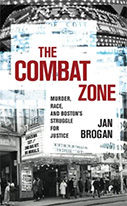The Combat Zone: Murder, Race, and Boston’s Struggle for Justice

Author: Jan Brogan
Publisher: University of Massachusetts Press, 2021. 240 pages.
Reviewer: Andrew J. Baranauskas | September 2022
The area of downtown Boston once known as the Combat Zone is far different today than it was decades ago. Today, the streets are lined with luxury apartment buildings and boutique shops. The streets are filled with tourists who have wandered off the Freedom Trail and university students heading to grab a coffee or check out the trendy new hot pot restaurant in Chinatown. It is a far cry from the heyday of the Combat Zone, when strip clubs and porno theaters were the main commercial enterprise of the area and where prostitutes, drug dealers, and hustlers were the common characters that roamed the streets. It was within this context that a crime shook the city in 1976 – and would forever change the Combat Zone.
In The Combat Zone: Murder, Race, and Boston’s Struggle for Justice, Jan Brogan explores the killing of Andy Puopolo and the legacy of this crime for the city of Boston. Following an end-of-season dinner for the Harvard University football team, Puopolo – a senior at the university who planned to attend medical school – accompanied his teammates in a traditional romp through the notorious Combat Zone. Brogan pieces together what happened that night from various eyewitness accounts: a prostitute is accused of stealing a wallet from one of the Harvard players, a scuffle ensues, local characters get involved in the fray, and Andy Puopolo ends up with two stab wounds in his chest.
To truly understand the importance of this crime and its aftermath, one needs to understand the social context of Boston, Massachusetts. Boston is a city of neighborhoods marked chiefly by ethnic and racial identity. The Combat Zone stood as a central hub where people of all ethnicities and races intermingled and partook in shady enterprises. It was here that Puopolo, a descendant of Italian immigrants from the North End, would be killed by a man and two alleged accomplices, all of whom were Black.
Brogan’s exploration of the racial context in which the crime occurred serves as a primer for race relations in the city of Boston. Racial tensions in the city were at a high in the mid-1970s. Children were being bussed across neighborhoods in an effort to sidestep the de facto segregation created by the insularity of Boston’s neighborhoods. This unpopular policy created anger and frustration in many Boston residents and led to demonstrations, riots, and racially-motivated attacks on students of all races and ethnicities. Given this racial context, it is no surprise that the alleged killing of a white man by three Black men would receive the media attention that it did.
Crime and media scholars have noted that the media love to report stories that focus on an “ideal victim.” Ideal victims are blameless and play no role in their victimization. They are individuals who have contributed to society (or have the potential to), making their loss a detriment to society as a whole. In other words, they elicit sympathy in their innocence and lost potential. In many ways, Andy Puopolo is an ideal victim. He was not only a gifted athlete, but a standout citizen who was admired by his friends and neighbors. He was on his way to climbing the societal ranks: emerging from a blue-collar immigrant family to attend the prestigious Harvard University to then potentially moving on to medical school and a career in medicine. The fact that it was three Black men who allegedly cut him down in his prime made the incident all the more newsworthy in a time of high racial tensions.
Certainly a highly-publicized case like this would create a significant public response and demands for swift action. In great detail, Brogan describes the process of seeking justice for Puopolo’s killing. The main characters here include an ambitious prosecutor who befriends the Puopolo family and takes a personal interest in the case; a hard-nosed judge known for dispatching justice efficiently; and a young defense attorney concerned with the legacy of racial discrimination that has tinged the American criminal justice system. Through interviews and court transcripts, Brogan pieces together the eyewitness testimony and legal maneuverings that led to guilty verdicts for all three defendants.
These verdicts, however, were far from final. Rather than achieving a just resolution, a host of questions lingered. Why were all three defendants convicted of premeditated murder when only one of the men – by his own admission – plunged the knife into Puopolo’s chest? Why were nearly all Back individuals in the jury pool excluded via the prosecutor’s peremptory challenges? If Puopolo was so innocent, what was he doing in the notoriously disreputable Combat Zone in the first place? And importantly, why did other cases in which the racial roles were reversed – a Black man killed by white assailants – receive comparatively little attention by the media, the public, and the criminal justice system?
An important aspect of justice is that it is more than just making sure that people who commit crimes are punished for them. Justice also requires that guilt is determined through a fair and impartial process, no matter the race, ethnicity, gender, religion, or any other characteristic of the suspect or victim. A lasting legacy of the Puopolo case for the American criminal justice system is that it led to important reforms in the jury selection process. The Supreme Judicial Court of Massachusetts found fault in the way that the jury was selected in the original trial, and, thus, vacated the convictions of all three defendants. This decision later inspired the U.S. Supreme Court’s Batson decision, which restricted the use of peremptory challenges to exclude potential jurors of color.
Returning to Boston, the changing racial context of the city had important implications for the quest for justice for Puopolo’s murder. Another crime involving a different football player would indicate a changing of the tide. In 1979, Black teenager Darryl Williams was shot in the neck as he stood with teammates on a football field in the largely white neighborhood of Charlestown. Williams was neither the aggressor nor involved in any nefarious activity; he was merely a fifteen-year-old kid who was the unfortunate landing place for a bullet shot from a nearby rooftop, paralyzing him from the neck down.
It was in the context of a public sympathetic to the shooting of Williams and other similar incidents that the second trial of Puopolo’s alleged killers took place. In this case, the defense also had the benefit of better attorneys, more time to prepare their cases, and the transcript from the original trial that they could use to exploit inconsistencies in eyewitness testimony. The trial, in this context, made for a much different outcome – an outcome that brings up even more questions about the achievability of justice.
In telling the story of the Combat Zone, Brogan weaves together ideas and concepts from a number of academic disciplines. She explores the urban sociology of Boston in describing the birth of the Combat Zone, as well as the social and economic factors that gave shape to Boston and its neighborhoods in the 1970s. Her investigation of race relations paints an important picture of the tensions and hostilities in which the killing and subsequent trials unfolded. She delves into the psychology of grief and victimization in examining the impact of Andy’s killing on his family and friends. And of course, she explores a number of ideas in criminology and the study of criminal justice, from retribution as a goal of the justice system to the jury selection process to racial disparities that have traditionally been inherent in criminal justice proceedings.
In many ways, the story of the killing of Andy Puopolo is the story of the city of Boston in the latter half of the twentieth century. It is a story of immigrants working toward the American dream, the strength of family and faith, and loyalty. It is also, unfortunately, a story of racial tension, organized crime, and the failings of the criminal justice system. It is a story that has led to positive impacts on Boston, from the decline and eventual demise of the Combat Zone to reforms aiming to root out racial disparities in the justice system. It is also a story of grief, disillusionment, and a search for meaning for the city’s residents. Ultimately, it is a story about a young man taken in the prime of his life and a city’s struggle for justice.
Andrew J. Baranauskas is an assistant professor in the Department of Criminal Justice at SUNY Brockport.


